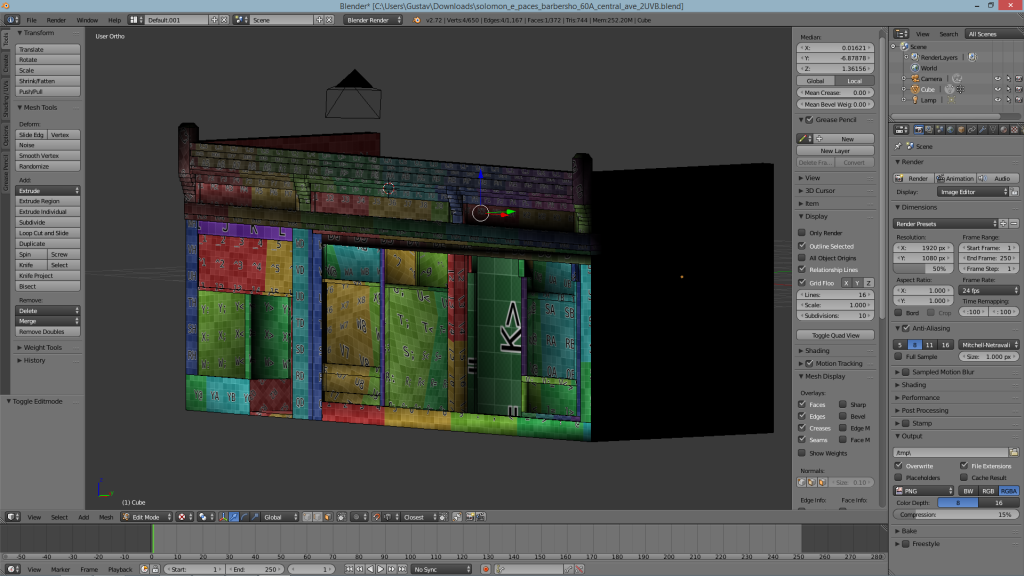*long sigh of relief*
Finally on the other side of a flu storm that started last week. The other good news is that I get to give you guys some updates on all the projects I’ve been working on.
Let’s start with the Digital Signage Project:

I turned in a final prototype for the Digital Signage Project to the Exchange to start the process of getting it on campus. It’s been a long road with that project but it’s worked out great! Both hands can be used to interact with the objects, but only the right hand can interact with the arrows that cycle through the different models. It will be very easy to add more models as we need them–I just need to drop a few files, add a few lines of code, and recompile the project to a flash drive. The colors and fonts used in the project are all official Georgia State University colors and fonts, and we even have our own official logo for the SIF program! If you guys get a chance, go play with this project at the Exchange and send in any feedback! It’s a basic prototype right now, but with time it can be expanded to do more! My main focus the past few weeks has been split between the 3D Atlanta project and the new NextEngine Scanners we have at CURVE.
NextEngine Scanners:
These things are great! They do a great job at getting small objects scanned in at incredible detail. They do have some issues with the color texture capturing however. The textures have zero color-correction done to them so the final textures often come out mottled–almost like a camo print of light and shadow is on top of it. Obviously that isn’t a great result and I’m currently working on ways to solve it–namely getting a small light studio setup to test out different lighting conditions. Pitch black doesn’t seem to work–so I’m going to try and do a bright environment. The problem is with the NextEngine’s internal camera flash–it’s very bright and I think what’s causing the drastic color differences between scans. In no light conditions–the flash is still too strong. My next attempt will be to put several light sources surrounding the object to create a strong ambient light level to offset the brightness of the machine’s flashes.
My goal with these scanners is to create a help file with Andrew and Nathan so that anyone can walk in and start using them by following a step-by-step guide that we’ve gotten all the kinks out of. Luckily the machine does a good job automating the process–it’s just a matter of tweaking a few settings.
3D Atlanta:


3D Atlanta is making some real headway this semester! A few of us are working on making actual models of the building facades we have! I’m nearly finished with my first one. The modeling is completely done–there’s only the texture left to do. I’ve already spent some time unwrapping the UV coordinates to decent pattern on the image–you can see the process in the screenshot: I have a colored grid for a texture that I slowly unwrap the faces of the mesh to, i.e., the rectangular 2d plane that is where a window is at on the building is mapped to a rectangular portion of the texture. It’s a time-consuming process, but it’s roughly half-done. While sick this past week I’ve been taking a break from that process–which requires a lot of mental focus–and dropped the model in Unity to start looking at ways of implementing interactivity with it–even without a texture. My next post will deal more with that aspect of it. We want the door to possibly trigger an interactive newspaper that takes up the screen, giving information or narrative about the building. A future prototype will be making the interior environments of the buildings–but that’s a ways away! For now we are focusing on getting a working prototype!
I hope everyone has had a good start to their semesters! Mine’s admittedly been a little rough, but I’m slowly getting back on my feet! Thesis defense is coming up fast and I’ve got a lot of work to do!
Cheers,
Robert Bryant





I’m really glad you survived to continue project work, Robert – and not just because these are some of the coolest projects we’re doing here in the SIF program. I’m really excited to see students playing with the Digital Signage Project – I’m going to guess that many of our students don’t know something like that is even possible.
I wonder what you envision students learning from the signage project? How might instructors use it?
It’s hard to ascertain the specific educational benefits of any new technology. Technology often improves at a speed greater than immediately apparent applications of use. This digital signage project however–I see it less as an educational tool in a traditional sense, and more as an example of student interactive engagement with their fellow students and university projects. For instance, several English Department students are working on building 3d models with attached creative narratives and the plan is to present some of their work on the digital signage program. I envision it as a platform of idea/exchange and promotion within GSU’s faculty and students and without. If an art student, for instance, built out a sculpture–if that student created a 3d model of it as a showcase, they could also display their work, promoting the actual exhibit in a unique and entertaining fashion that’s accessible to students.
Those are my thoughts though. I’m sure there are educational applications–like doing biological dissections–but that kind of programming is outside the range of my time and ability at the moment.